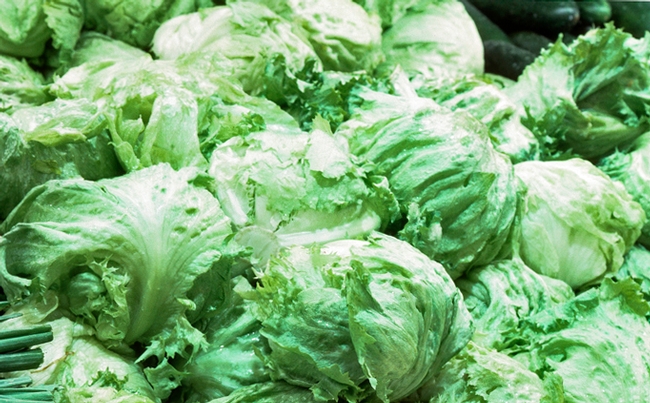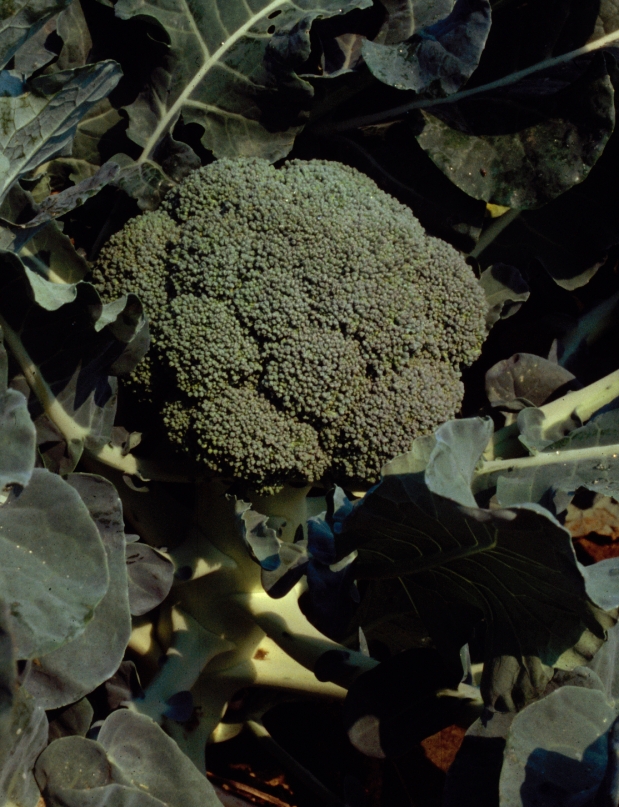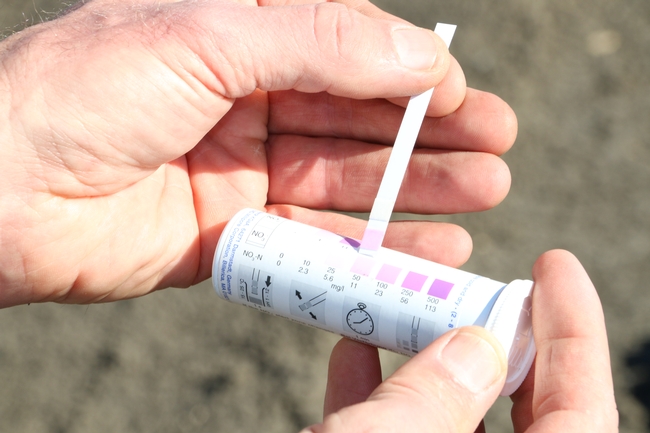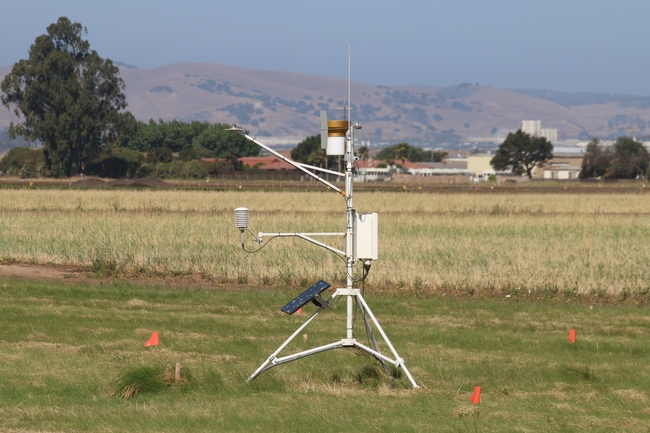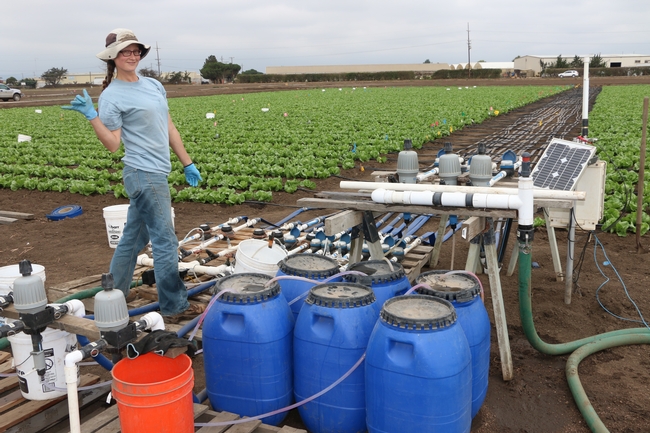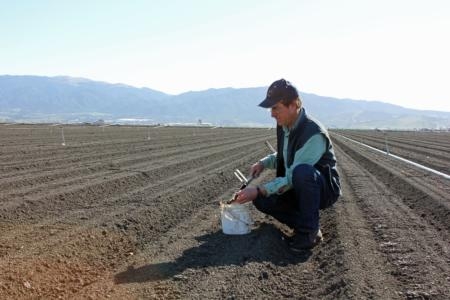Posts Tagged: Richard Smith
Broccoli and lettuce cost studies released by Agricultural Issues Center
New studies with sample costs to produce and harvest iceberg lettuce and broccoli for fresh market in Monterey, Santa Cruz and San Benito counties have been released by UC ANR Agricultural Issues Center and UC Cooperative Extension. Vegetable growers may find these useful for estimating their own production costs and potential returns on investment.
“These studies have an expanded section on labor, which includes information on California's new minimum wage and overtime laws,” said Laura Tourte, UC Cooperative Extension farm management advisor in Santa Cruz, Monterey and San Benito counties, who co-authored the study.
The analysis is based on a hypothetical well-managed farming operation using practices common to the Central Coast Region. The costs, materials and practices shown in this study will not apply to all farms. Growers, UC ANR Cooperative Extension farm advisors and other agricultural associates provided input and reviewed the methods and findings of the study.
Both studies assumes a farm operation of 1,500 non-contiguous acres of rented land. The hypothetical iceberg-lettuce farm has 250 acres planted to iceberg lettuce. The lettuce is hand-harvested into 42-pound cartons containing 24 film-wrapped heads. The hypothetical broccoli farm has 500 acres planted to broccoli. The broccoli is hand-harvested into 21-pound bunch cartons. On each farm, the remaining acreage is assumed to be planted to other cool season vegetable crops.
The authors describe the assumptions used to identify current costs for production material inputs, cash and non-cash overhead. Ranging analysis tables show net profits over a range of prices and yields. Other tables show the monthly cash costs, the costs and returns per acre, hourly equipment costs, and the whole farm annual equipment, investment and business overhead costs.
Free copies of “Sample Costs to Produce and Harvest Iceberg Lettuce in the Central Coast - 2017” and “Sample Costs to Produce and Harvest Broccoli in the Central Coast - 2017” and other sample cost of production studies for many commodities are available. To download the cost studies, visit the UC Davis Department of Agricultural and Resource Economics website at https://coststudies.ucdavis.edu.
The cost and returns studies program is funded by the UC Agricultural Issues Center and UC Cooperative Extension, both of which are part of the UC Division of Agriculture and Natural Resources, and the UC Davis Department of Agricultural and Resource Economics.
For additional information or an explanation of the calculations used in the studies, contact Jeremy Murdock of the Agricultural Issues Center at (530) 752-4651, Richard Smith UC Cooperative Extension advisor in Monterey County, at (831) 759-7357 or Tourte at (831) 763-8005.
California nitrogen assessment presents opportunities for improvement
Plants need nitrogen to grow, but excess nitrogen – from livestock facilities, septic systems, car exhaust and other sources – that escapes into groundwater and the air can impact the environment, human health and the climate.
A new report from the Agricultural Sustainability Institute at UC Davis offers a big picture look at the scale and impacts of nitrogen in California. According to the California Nitrogen Assessment, excess nitrogen in the state comes primarily from agriculture and fossil fuel combustion.
The report, published by UC Press, offers a scientific foundation to develop practices and policies that allow nitrogen's benefits while reducing the risk.
For years, UC Agriculture and Natural Resources scientists have been working with farmers throughout the state to refine fertilizer management, irrigation efficiency and other farming practices to manage nitrogen, and the work continues.
The following are some examples of UC ANR research and extension projects underway.
App helps farmers better manage nitrogen fertilizer and water
Growers can use CropManage, developed by Michael Cahn, UC Cooperative Extension advisor in Monterey County, and UC ANR Communication Services and IT staff, to track and manage water and nitrogen fertilizer applications for their crop fields. The online application can be used on mobile devices or computers to help farmers use two tools to conserve water and make better use of nitrogen fertilizer while maintaining crop productivity and quality. Growers use the soil nitrate quick test in the field to measure the nitrogen level of their soil and the app to determine the optimal level of nitrogen fertilizer to apply based on UC ANR research on crop nitrogen use. CropManage also recommends water needs of a crop from weather station data and crop development models.
Matching nitrogen applied to crop need improves efficiency
Richard Smith, UC Cooperative Extension advisor in Monterey County, is leading several research projects evaluating the nitrogen requirements of vegetables including including cole crops, spinach, baby lettuce, a salad mix and cilantro. Smith is evaluating crop rotations with broccoli to scavenge nitrogen from the soil profile. He is also evaluating slow-release fertilizers to minimize nitrate leaching losses in shallow-rooted crops such as baby lettuce and spinach in the Salinas Valley.
Wood chips remove nitrogen in tile drain water
Using wood chips and supplemental carbon sources, Tim Hartz, UC Cooperative Extension specialist in the UC Davis Department of Plant Sciences, worked with Cahn and Smith to refine a process to remove nitrate from tile drain water, which typically is very high in nitrate. The carbon in the wood chips supports the activity of anaerobic bacteria that chemically reduce the nitrate to N2, a benign gas.
Irrigation water fertilizes vegetables
Water quality regulations in many regions of California now require farmers to report the amount of nitrogen fertilizer that they apply to their fields and the nitrate concentration of their irrigation water. Smith, Hartz and Cahn have just finished three seasons of field trials that demonstrated that the nitrate in groundwater supplied a substantial portion of the fertilizer requirements for lettuce and broccoli. By accounting for the nitrate in irrigation water and using the soil nitrate quick test to monitor soil nitrogen levels, growers may be able to significantly reduce the amount of fertilizer nitrogen they apply to vegetable crops.
Micro-irrigation offers almond growers a tool to control leaching
The majority of almond growers apply fertilizer through micro-irrigation systems and an increasing number of growers are irrigating with water that is saline. Patrick Brown, professor in the UC Davis Department of Plant Sciences, is studying how to use micro-irrigation to reduce nitrate leaching and manage soil salinity by varying the frequency of irrigation and the length of time water is applied during irrigation.
Managing irrigation to reduce nitrate leaching
To identify the best irrigation management practices to control soil salinity and to minimize nitrate leaching to groundwater, Laosheng Wu, professor and UC Cooperative Extension specialist in the UC Riverside Department of Environmental Sciences, is using computer simulation to consider soil, water, crop nitrogen demand and fertilization with irrigation methods. In collaboration with UC Cooperative Extension advisors, Wu is conducting field experiments on alfalfa in Imperial County, almonds in the Central Valley and avocados at South Coast Research & Extension Center in Orange County to validate the simulations.
Online tool being developed to estimate soil nitrogen mineralization rates
To develop a tool for growers and crop advisers to estimate soil nitrogen, Daniel Geisseler, UC Cooperative Extension specialist in the Department of Land, Air, and Water Resources at UC Davis, is gathering data throughout California to estimate field-specific nitrogen mineralization rates. This project, funded by UC ANR's California Institute for Water Resources, will use nitrogen mineralization data to develop an online tool to help growers adjust their applications of fertilizer. The tool has the potential to increase nitrogen use efficiency in crop production, resulting in lower risks of nitrate leaching to groundwater.
Nitrogen management training for Certified Crop Advisers
Between 2014 and 2016, approximately 900 Certified Crop Advisers participated in a nitrogen management training program coordinated by UC ANR's California Institute for Water Resources with support from CDFA's Fertilizer Research and Education Program. The technical and applied training improves CCAs' understanding of sound nitrogen management practices to make informed recommendations to growers.
The California Nitrogen Assessment book
The book, “The California Nitrogen Assessment: Challenges and Solutions for People, Agriculture, and the Environment,” is available for purchase at ucpress.edu. The 20-page executive summary can be downloaded for free at asi.ucdavis.edu.
This story is also available in Spanish: "La evaluación del nitrógeno en California ofrece oportunidades para mejorar http://ucanr.edu/sites/Spanish/Noticias/boletines/?uid=6884&ds=199
Working to achieve healthy crops while limiting nitrate in water
UC Cooperative Extension and Agricultural Experiment Station researchers are working with growers on fertilizer management, irrigation efficiency and other farming practices to provide options for protecting groundwater, which serves as a primary drinking water source for many rural communities. The following are some examples of ANR research and extension projects under way. The scientists’ names are hyperlinked to their contact information.
Quick nitrate test guides fertilizer management
Michael Cahn and Richard Smith, UC Cooperative Extension advisors in Monterey County, and Tim Hartz, UCCE specialist in the department of Plant Sciences at UC Davis, have developed a quick test to measure soil nitrate in the field so growers can match fertilizer rates with plant needs. The test has reduced nitrogen-loading rates by an average of 70 pounds per acre in lettuce. On-farm demonstration trials have shown that by testing the soil, growers can reduce their fertilizer use by about 30 percent. Major growers in Monterey County, who manage a significant number of vegetable acres in the Salinas Valley, have begun using the quick nitrate test in their operations. For more information read the summary article on p. 5 and fine tuning article on p. 12 of Crop Notes.
Assessing plant nutrient status
Leaf sampling is a common method of determining when a nut tree has a nutrient deficiency. Patrick H. Brown, professor in the Department of Plant Sciences at UC Davis and Agricultural Experiment Station pomologist, and his colleagues are studying other ways of assessing plant nutrient status to help almond and pistachio growers manage fertilizer applications with more precision. For more information, see Crop Nutrient Status and Demand.
NBOT aids dairies in nutrient planning
The Nitrogen Budget Optimization Tool (NBOT) is a planning tool being developed for dairies by David Crohn, professor and UC Cooperative Extension specialist in the Department of Environmental Sciences at UC Riverside. NBOT is an algorithm that uses a daily time step to represent crop nitrogen demand, nitrogen mineralization and losses from leaching, denitrification and ammonia volatilization. Typical nitrogen application charts tell how much nitrogen a crop needs during the growing season, but they do not say when the crop will need it. With NBOT, dairy operators input information about the crop they are growing, how much they expect to harvest and when they can apply manures. NBOT’s output gives an idealized management strategy that helps dairy operators decide what they should do all year round.
N-Ledger software addresses nitrogen management
A software program under development by a team headed by Marsha Campbell Mathews, UC Cooperative Extension advisor in Stanislaus County, will help dairy operators and other farmers improve nitrogen management by calculating when nitrogen applied in manure is expected to be released from organic form into a form that the crops can use. Nitrogen applications are tracked, release rates are estimated and adjusted for expected losses, and the calculated total is compared to the expected daily crop need for nitrogen. The program helps the user choose an application strategy that will meet the crop’s needs and result in the least possible amount of nitrate in the soil during periods when it is vulnerable to leaching or other losses. For more information, see the UC Cooperative Extension in Stanislaus County Manure Nutrient Management website.
Adjusting field length can reduce irrigation levels
In his research on how dairy operators can reduce water applications to their crops, Larry Schwankl, UC Cooperative Extension specialist at Kearney Agricultural Research and Extension Center in Parlier, has found that allowing less water to percolate will reduce impacts on groundwater. With shorter furrows, water applied per acre was cut nearly in half. In addition, manure water is often added to fresh water as part of dairy irrigation and fertigation practices, so being able to reduce the applied water also significantly reduces the amount of nitrogen applied. For more information, see Schwankl's Irrigation Management website.
UC helps dairy industry manage nitrogen on the farm
It is common practice for dairy operators to use cattle manure as fertilizer for their silage crops. UC Cooperative Extension advisors throughout California routinely provide reliable information to dairy operators and consultants so they can efficiently manage nitrogen on the farm and comply with pending state regulations. This information includes how to install and calibrate flow meters, how to measure nitrogen levels in manure ponds, how much nitrogen crops need and when they need it, and how to properly sample the crops that are harvested to know how much nitrogen is being removed. “We’ve developed protocols to ensure accurate information gathering, and we can share these with the dairy industry,” said Carol Frate, UCCE advisor in Tulare County. For more information, contact a UC Cooperative Extension dairy advisor.
To see other ANR projects and publications aimed at limiting nitrate leaching, please visit http://ucanr.edu/News/Healthy_crops,_safe_water.

